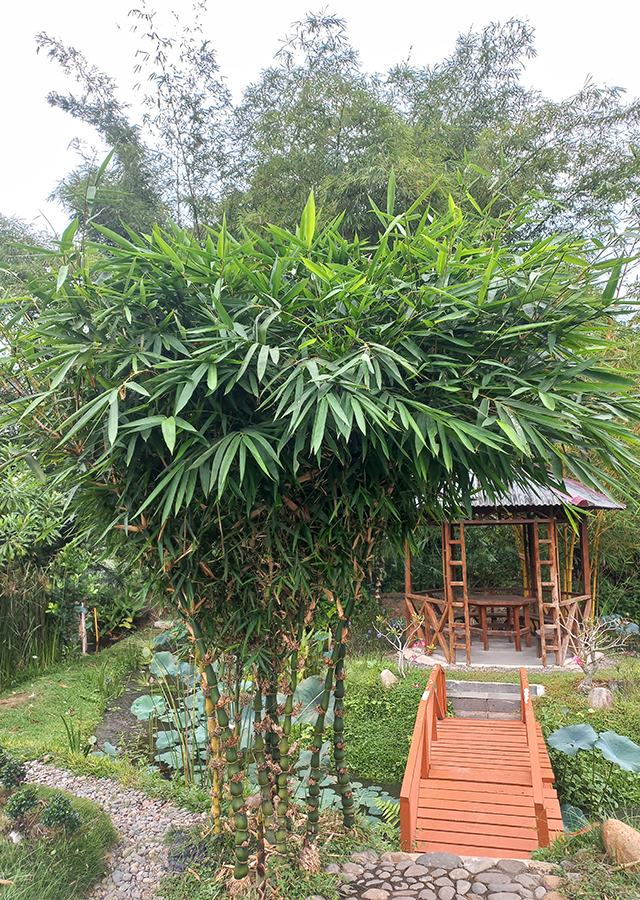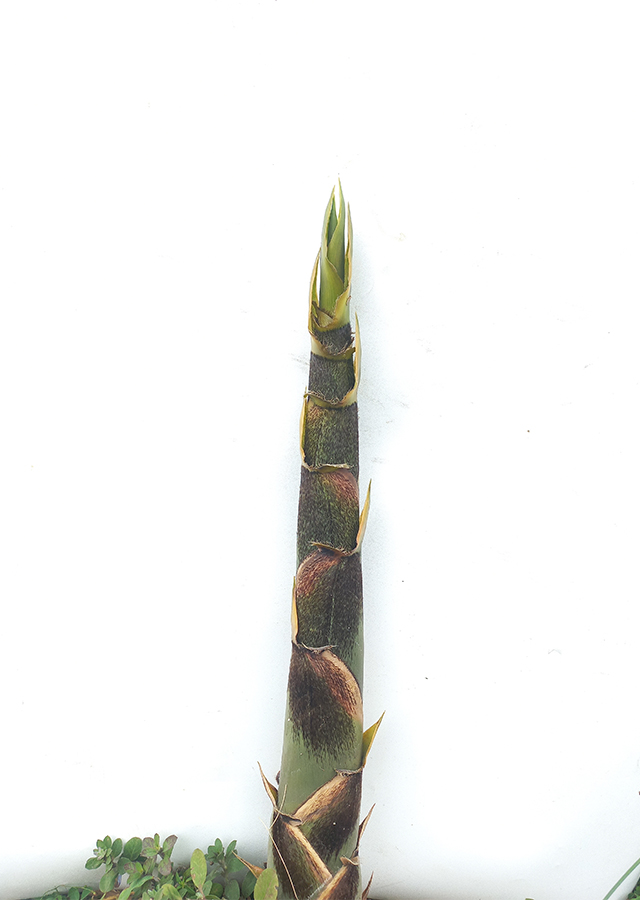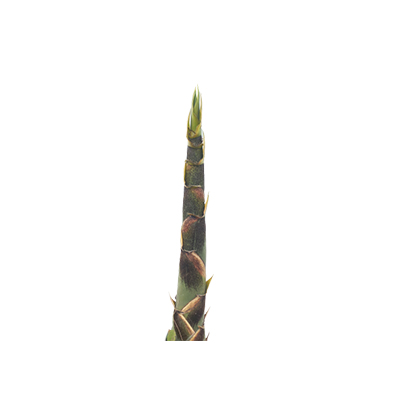Buddha bamboo
Bambusa ventricosa McClure
Poaceae
Location in our garden
Aquatic



Synonym
Leleba ventricosa (McClure) W.C.Lin
Habitus
Bamboo. Bamboo, perennial, 3-6 m in height
Part Used
Shoots
Leaves
Growing Requirements
Full Sunshine
Need Shade
Habitat
Riverbanks
Mountains
Terrestrial
Overview
Bambusa ventricosa is a species of bamboo which is native to Vietnam and the province of Guangdong in southern China. This species is widely cultivated in subtropical areas around the world as an ornamental plant because of the uniqueness of its stems. This species is also used in making bonsai. The young stems of this bamboo can be consumed as vegetables. The young leaves and stems have long been believed to be used in traditional Chinese medicine to treat health disorders.
Vernacular Names
Buddha's-belly bamboo, Swollen Stemmed Bamboo (English), Butto chiku (Japanese).
Agroecology
Buddha Bamboo reportedly grows well in tropical regions. This species is grows in fullsun to partial shade. Requires fertile, humus-rich, well-drained soil. This plant likes warm and humid climates, tolerates cold/low temperatures, can withstand light frosts and extreme low temperatures around 0.
Morphology
- Culms - dimorphic; normal culms 8–10 m, 3–5 cm in diam., basally flexuose, apically slightly drooping; internodes 30–35 cm, basally slightly swollen, not white powdery, initially glabrous; lower nodes with rings of gray-white silky hairs below and above sheath scar; branching from 3rd or 4th node up, basal 1 or 2 nodes also with short aerial roots; branches 1–3 on lower nodes; branchlets of these sometimes condensed into weak thorns; branches several to many at mid-culm and upper nodes, with central 3 slightly longer and thicker. Abnormal culms (usual in potted plants) 25–50 cm, 1–2 cm in diam., internodes shortened and swollen at base, branch internodes also shortened and swollen; branches only on upper nodes, usually solitary, without thorns. Culm sheaths deciduous, obviously ribbed-striate, glabrous, apex nearly symmetrical, broadly arched or subtruncate; auricles unequal; larger auricle narrowly ovate to ovate-lanceolate, 5–6 mm; smaller auricle ovate, 3–5 mm; oral setae curved; ligule 0.5–1 mm, very shortly finely fimbriate; blade deciduous, erect or recurved, ovate to ovate-lanceolate, base slightly arched, narrowed, slightly narrower than sheath apex.
- Leaves - Leaf sheath glabrous; ligule subtruncate, very short; auricles ovate or falcate; oral setae several, curved; blade linear-lanceolate to lanceolate, 9–18 × 1–2 cm, abaxially densely pubescent, adaxially glabrous.
- Pseudospikelets - solitary or many clustered on each node, linear-lanceolate, slightly compressed, 3–4 cm; prophylls oval, 2.5–3 mm, 2-keeled, apex obtuse; gemmiferous bracts 1 or 2, narrowly ovate, 4–5 mm, 13–15-veined, apex acute; florets 6–8, basal 1 or 2 and apical 2 or 3 usually sterile; rachilla segments flat, 2–3 mm, apex inflated and cupular. Glumes absent or 1, ovate-elliptic, 6.5–8 mm, 15–17-veined, apex acute; lemma ovate-elliptic, 9–11 mm, glabrous, 19–21-veined, apex acute; palea nearly as long as lemma, ciliolate near apex, 4-veined between and on either side of keels, apex acuminate with a cluster of white hairs; lodicules 3, ca. 2 mm, margins long ciliate, anterior 2 slightly asymmetrical, posterior broadly elliptic. Filaments slender; anthers yellow, ca. 6 mm, apex obtuse. Ovary broadly ovoid, 1–1.2 mm, stalked, apex thickened and hairy; style very short, hairy; stigmas 3, ca. 6 mm.
- Fruit unknown.
Cultivation
Propagation by seeds and cuttings.
Chemical Constituents
Tannins, polyphenols, saponins, general and cyanogenic glycosides, flavonoids, coumarins.
Traditional Medicinal Uses
- Remove toxins from human body.
- In Chinese medicine, shavings of culm cortex (chuk yu) used for febrile diseases, hematuria, epistaxis and infantile epilepsy.
- In traditional Chinese medicine, it is considered cooling, calming, and phlegm resolving, used in many formulas to treat lung.
- In Africa, traditionally used in the treatment of various types of fever.
Part Used
Reference Sources
- Flora of China. Bambusa ventricosa. FOC Vol. 22 Page 10, 11, 17, 24. http://www.efloras.org/florataxon.aspx?flora_id=2&taxon_id=242307748. 24-07-2022.
- G. Y. Coffie, C. Antwi-Boasiako, N. A. Darkwa. 2014. Phytochemical constituents of the leaves of three bamboo (Poaceae) species in Ghana. Journal of Pharmacognosy and Phytochemistry 2014; 2 (6): 34-38. https://www.researchgate.net/publication/279963419_Phytochemical_constituents_of_the_leaves_of_three_bamboo_Poaceae_species_in_Ghana. 24-07-2022.
- Iris. Raya Gardens. 2021. Buddha Belly Bamboo: Grow & Care for Bambusa Ventricosa. https://www.rayagarden.com/garden-care/buddha-belly-bamboo-grow-care-for-bambusa-ventricosa.html. 23-07-2022.
- MedicinalLive. 2018. Bamboo buddha belly – Bambusa ventricosa. https://medicinallive.com/product/bamboo-buddha-belly-bambusa-ventricosa/. 23-07-2022.
- Stuartexchange. 2020. Buddha Bamboo. http://www.stuartxchange.org/BuddhaBamboo. 23-07-2022.

